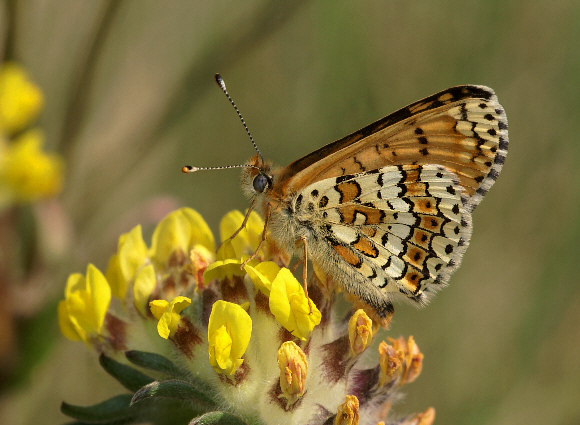 Glanville Fritillary Melitaea cinxia, male, Hampshire coast – Adrian Hoskins
Glanville Fritillary Melitaea cinxia, male, Hampshire coast – Adrian Hoskins
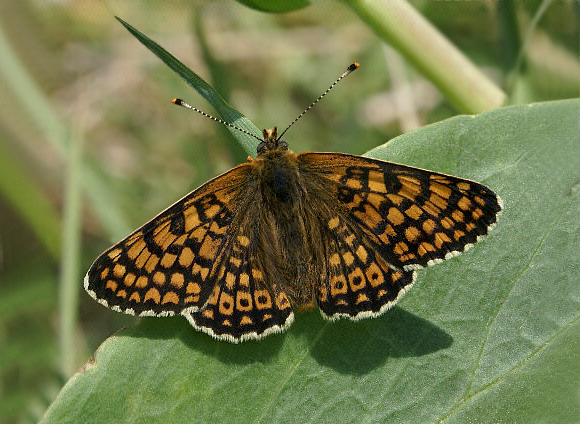 Glanville Fritillary Melitaea cinxia, male, Wheelers Bay, Isle of Wight – Adrian Hoskins
Glanville Fritillary Melitaea cinxia, male, Wheelers Bay, Isle of Wight – Adrian Hoskins
Introduction
The Glanville Fritillary is named after Eleanor Glanville who originally discovered the butterfly in the 18th century at a woodland in Lincolnshire. There is a well known story that Lady Glanville’s will was contested on the grounds that she must be guilty of “Acts of Lunacy” because only someone who was “deprived of her senses” would go in pursuit of butterflies!
This piece of history serves to demonstrate a very strange misconception regarding naturalists in the past. It is also a stark reminder of how much more widespread and abundant butterflies were before the Industrial Revolution destroyed the British landscape. A cooling climate also probably contributed to the decline of this species, as its range gradually contracted further and further southwards. At the middle of the 19th century it was still common along the Kent coast, but by the beginning of the 20th century it had become restricted to a handful of sites along the south coast of the Isle of Wight – the only part of Britain where it breeds naturally today.
Abroad it occurs across most of mainland Europe with the exception of Portugal, central & southern Spain and northern Scandinavia. It also occurs in the Atlas mountains of Morocco, and in temperate Asia from the middle east to Mongolia.
There are no other similar species in Britain. However in Europe it can easily be confused with the Knapweed Fritillary Melitaea phoebe or with Freyer’s Fritillary Melitaea arduinna. The latter is a local species restricted to south-east Europe.
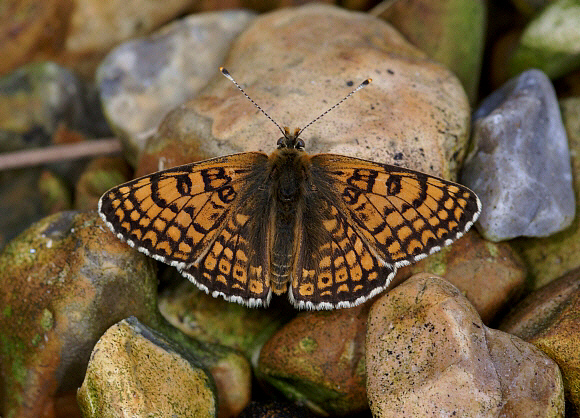 Glanville Fritillary Melitaea cinxia, male, Hampshire – Adrian Hoskins
Glanville Fritillary Melitaea cinxia, male, Hampshire – Adrian Hoskins
Habitats
In Europe the Glanville Fritillary is found in a wide range of habitats including woodland glades, sub-alpine meadows, field edges, and open grassland.
In Britain it is at the edge of it’s range and is only able to survive at a handful of particularly warm sites along the south coast of the Isle of Wight. The critical factor is probably the amount of sunlight which sites receive in late winter and early spring when the caterpillars awaken from hibernation – the Isle of Wight receives more hours per day of sunlight at this time of year than elsewhere.
The butterfly breeds primarily on severely eroded sandstone undercliffs, where the larval foodplant ribwort plantain grows in profusion, and where the extensive areas of exposed ground create a very warm micro-climate. Most sites only support colonies for a few years because they soon become overgrown, lowering the micro-climate until it eventually becomes too cool for the species. Luckily regular land slippages create new areas of habitat which the butterfly can colonise, and the status of the butterfly on Wight remains fairly stable. Sea defence constructions and tourist developments do nevertheless threaten to destroy several of the butterfly’s breeding sites.
Away from the coast the butterfly also breeds periodically on the chalk grassland hillsides on the southern half of the island, but these colonies tend to last only a year or two.
Occasionally temporary colonies become established on mainland Britain, e.g. at Hordle Cliffs and Hurst Castle. They typically flourish for 2 or 3 years, but then disappear. They are almost certainly the progeny of single females which periodically find their way across the Solent, so the genetic diversity of each colony is minimal. After a few generations genetic entropy weakens the stock, reducing the viability of the colony, and rendering it prone to extinction.
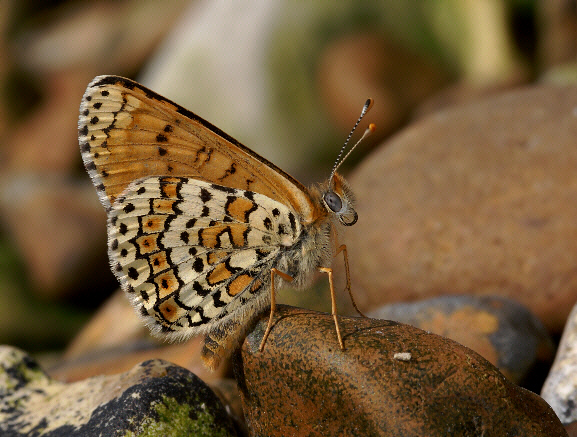 Glanville Fritillary Melitaea cinxia, male, Hampshire – Adrian Hoskins
Glanville Fritillary Melitaea cinxia, male, Hampshire – Adrian Hoskins
Lifecycle
In warmer parts of Europe the butterfly is double brooded, but in Britain there is usually only a single generation of adults. These normally begin to emerge in mid-May and remain flying until mid-June, but in exceptionally warm years the butterflies can appear at the end of April, and only remain on the wing until late May. In such years there may be a partial 2nd brood, emerging in August.
The eggs are yellow, and laid in batches of up to 200 on the underside of leaves of ribwort plantain Plantago lanceolata, where it grows in sheltered depressions or crevices. A wider range of plants is used in Europe, including various other Plantago species, plus Centaurea and Veronica. Usually the entire batch is laid at once, a process that may take 2 days, but sometimes the females lay smaller batches of only about 50 eggs, on plants at different parts of the breeding site. The eggs hatch after about 10 days, in late May.
The larvae are black and spiky with reddish-brown heads. They feed gregariously and bask on silk webs which they spin over plantains. In September, when in the 3rd or 4th instar, they leave the plantains, and spin a dense web amongst tall grasses. There they hibernate until early March. Upon awakening they feed in swarms which march across the undercliffs consuming every plantain they encounter. Often large numbers of the larvae can be seen wandering on footpaths, but fortunately most seem to avoid being crushed. In April, when almost fully grown, they become more solitary. The rate of growth varies from one larva to another with the result that there are usually still many larvae around in May when the first male butterflies emerge.
The pupae are greyish, marked on the abdomen with bands of small orange and black spots. They hang by the cremaster from grass stems, roots, or stones. Normally they pupate singly, but clusters of 4 or 5 are sometimes found in crevices. The pupal stage lasts about 2 weeks.
 Glanville Fritillary Melitaea cinxia, male, Hampshire – Adrian Hoskins
Glanville Fritillary Melitaea cinxia, male, Hampshire – Adrian Hoskins
Adult behaviour
The butterflies have a rapid whirring flight, usually close to the ground, and rarely fly more than a few metres at a time. Periodically they settle to bask on low foliage or bare ground. They also often settle with wings closed, amongst pebble or on the flower heads of plantain, sea purslane or thrift. There are few experiences more enchanting than watching a group of Glanville Fritillaries at rest on the pink flowers of thrift, swaying gently in the breeze, with the sound of waves lapping the shore.
Males patrol irregular beats across the breeding sites, and intercept all other Glanville Fritillaries of either sex. If a male meets a female that has already mated, she settles amongst low grasses and flutters her wings rapidly, then raises her abdomen as a rejection signal. If the male persists she then closes her wings and remains completely still until the male loses interest and flies off. When a male encounters a virgin female copulation takes place almost immediately without any preliminary courtship ritual, and the pair remain copulated overnight.
Typical breeding sites have a wide range of potential nectar sources including thyme, sea purslane, sea kale, red clover and birds foot trefoil, but the butterflies ignore most of these in favour of thrift, hawkweeds, buttercups, kidney vetch and red valerian.
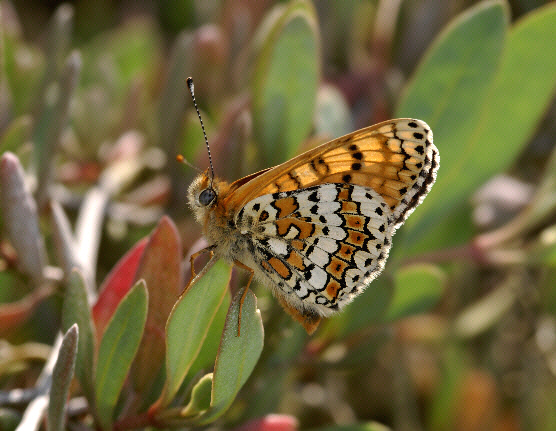
Glanville Fritillary Melitaea cinxia, male, Hampshire – Adrian Hoskins
In dry weather the butterflies roost overnight on flowerheads of ribwort plantain, sea purslane or thrift, but when there is any threat of rain they hide deep in grass tussocks or among clumps of horsetail. In windy conditions they also commonly hide in crevices in the undercliffs.
